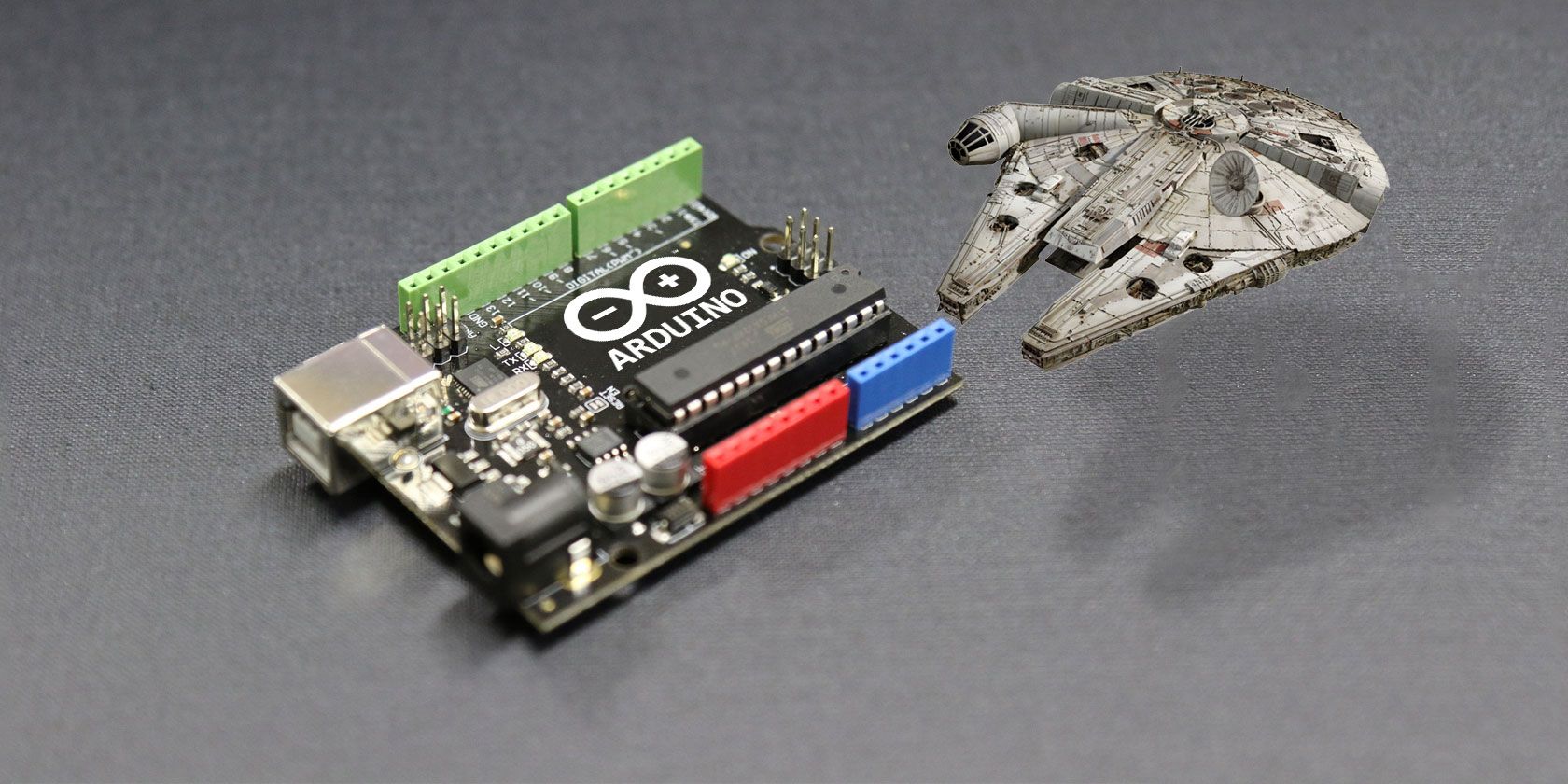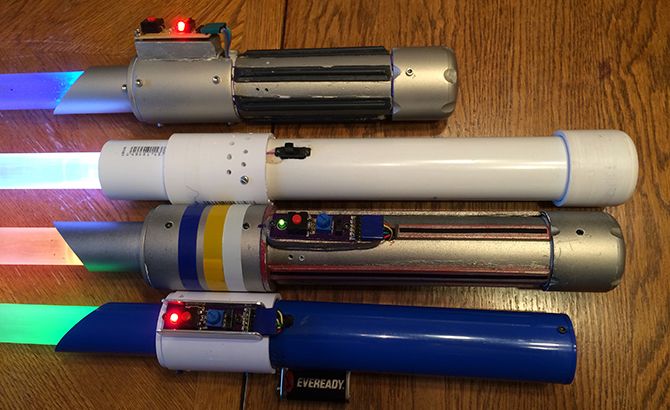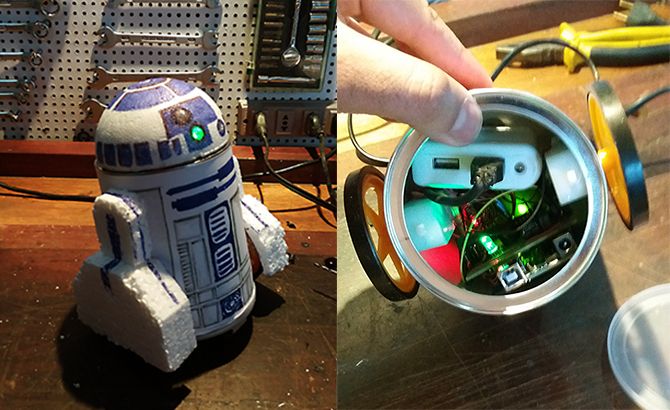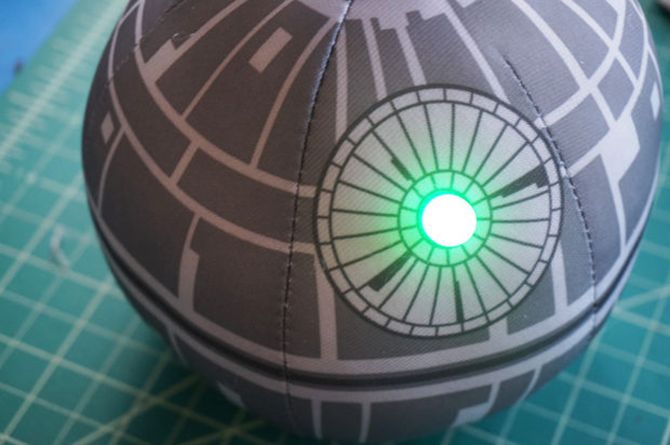With The Last Jedi almost upon us, Star Wars fans the world over are waiting with baited breath. What should you be doing to pass the time until release day? Between the games and books, there are already many ways you can experience the Star Wars universe.
What if that's not enough for you? If you are a more hands on person who loves tinkering with DIY electronics in your spare time, then this is for you!
In this article we will cover some Arduino based Star Wars projects you can make on a budget. Some of these projects only cost a few dollars, some of them up to $40. We've also included links to some bigger projects, and while none of them could be described as budget conscious, they are just way too cool to ignore.
1. Imperial Death Buzzer
Piezo buzzers are included in many Arduino starter kits, and are a great way to add sound to projects, we used one in our Buzz Wire Game with Arduino tutorial. Instructables user eserra used one to play the always foreboding Imperial Death March. The project is powered by an Arduino UNO board, though any other Arduino compatible board will work just fine.
This video was taken from the tutorial on Instructables, and uses the built in tone library for Arduino. The build also has an LED included which lights up in time with the tune. Code is provided for the tune, which can of course be modified to create more suitable tunes for all of the Rebel scum out there!
2. Bluetooth BB-8
This BB-8 fan build is a great testament to what can be achieved on a budget. This rolling droid started life as a hamster ball. After replacing the hamster with DIY tech, and giving the whole thing a facelift, the budget Bluetooth BB-8 was born. Best of all, it can be made for only $40!
The innards of the droid are controlled using an Arduino Uno with a HC06 Bluetooth module, a pair of motors driven by a motor shield, and a servo for the head. The detailed Instructable by Imetomi has directions for building the circuit using an Arduino Uno or a LinkIt One board.
For an easy to print out and follow guide, look at the bottom of the Instructable page, where a PDF file has been provided outlining every step with multiple images, along with all the code required to get it working.
The droid is controlled using a Bluetooth app, and is also compatible with voice control. This cheap but fairly complex build is every Star Wars fan's dream. Who wouldn't want to shout for their droid and have it come to them?
Special Mention: Life-Size BB-8
Ok, so this one totally blows the budget but it is so very, very cool:
The build is designed by ASCAS who has provided an Instructable for it, and with the full build coming in at around $120, it's still cheaper than many Star Wars toys. Bravo sir, we salute you!
3. Lightsabers at Dawn
We couldn't make a Star Wars post without a DIY Lightsaber in it, but the real challenge is finding one that Arduino lovers on a budget can make. Luckily, Carlos Vadillo has us covered with his low cost Lightsaber designs.
The design process for these custom sabers is documented on the builder's website, and uses very cheap parts to great effect. The lighting is taken care of using a single 3W RGB LED in the base. The use of a more powerful LED means less overall materials while keeping the price low (similar LEDs can be found on Aliexpress for less than $6).
The build is possible with a cheap cloned Nano board, and the project initially used one. In the end the builder opted to use an Adafruit Pro Trinket board which is still a cheap option at $10, but does bump the overall price up a little. With an accelerometer taking care of the colour changing trigger, and an AA battery holder powering the whole unit, this Lightsaber is a great alternative to the more expensive options available.
Special Mention: Super Saber!
The video is taken from a tutorial by Jeremy Lee, and shows the Lightsaber being tested at a party. The tutorial is in depth, and covers every aspect required to make a fantastic bright looking Lightsaber that sounds, looks and feels good.
With the parts outlined in the tutorial, this build comes in at around $140, which isn't too much to ask for a custom light sword at the end of the day, but might be out of the price range of a tinkerer on a budget.
4. R2-D2
Costing less than $15, this budget R2-D2 build combines everything we love about DIY electronics. It's put together using simple parts, works well, and looks good given that the whole project likely costs less than $15.
What really makes this project stand out is the approach the builders took to driving the motors. Rather than buying a specific motor shield, they designed and built their own multi use shield using cheap parts. The design for the shield is discussed in the tutorial, and all of the components cost between a few cents and a dollar.
Code is provided in the tutorial, and control of the droid is achieved through a HC-06 Bluetooth module which you can command from any smart phone. This build is not simple by any means, and only experienced DIY folks should attempt it, but it is a fantastic inspiration for what can be done with limited means.
Special Mention: 3d Printed, Fully Functional R6 Droid
Maker James Bruton saw the various DIY R2-D2 droids out there and thought he could do better! This led to a lengthy process of designing and building a fully functional 3d printed R6 droid. I cannot even begin to imagine the final cost of this project, but it is documented from start to finish on James's YouTube channel.
5. Rolling Star of Death
Next up, something a little more light hearted for all of us Imperial sympathisers. What could be cuter than a rolling and singing ball of death designed to destroy planets? According to Instructables user simsalapim, nothing!
Head to the Instructable to see video footage of it in action. The heart of this cute rolling sphere of evil is a LightBlue Bean board, though at the time of writing these $30 boards are unavailable. The same effect could be achieved using almost any Arduino compatible clone board (we recommend a NodeMCU) and an accelerometer, which makes this build cheap for the intrepid maker. The plush toys [Broken URL Removed] are available from various sellers online for around $20.
The sound is produced using a piezo buzzer, and the rest of the components are cheap generic parts usually found in any Arduino starter kit. The basics of this build can be used to make many different things -- anything that links movement to sound. This project makes for a great introduction to principles like using sensor data to trigger different outputs, and you end up with a squishy tuneful Death Star at the end.
6. Who Are You Looking AT-ST?
Taking already existing toys and modding them to do cool stuff is exactly what we like to see, and this modified AT-ST model does exactly that.
Using two cheap electret mic modules, this build allows the AT-ST to pinpoint the direction of an audio source. It uses this data to communicate with a servo, turning the head towards the origin point. The build by Pardopoz, outlined on their Instructable tutorial, has an Arduino Nano at its core, though any compatible Arduino board or clone will be fine.
The build uses many parts you will find in an Arduino starter kit, as well as scavenging parts from old computers, keeping the cost of this build low. You can further lower the cost by omitting the plaster on the base, or the expensive ring LED button while retaining the functionality of the overall project.
The AT-ST model is the only part which can be difficult to get cheaply, as they generally sell for around $30 online, though they do go for as little as $15 in used condition. Given how awesome the finished product looks, this might be a project worth saving for if you are on a limited budget!
Special Mention: AT-ATtention Please!
This project blows budget out of the window, but we couldn't leave it out. Dave Stein made quite a splash a couple of years ago as details of his AT-AT project appeared. Using an Arduino Uno along with a large array of different servos and aluminium framing, this project allowed a model AT-AT to actually walk.
The full parts list and brief overview is available at the atatproject website, but as for making your own you'll have to work it out for yourself as there is no tutorial available.
Good luck with the knees!
7. Darth Vader Voice Changer
Sounding like Darth Vader is at least 12 percent as cool as being Darth Vader. It's a good thing that Adafruit have us covered then, with their easy to follow and incredibly detailed Wave Shield Voice Changer tutorial.
This build makes use of some of the Adafruit line, including their Wave Shield for outputting sound, and their electret mic amplifier. Even with these parts, the build remains cheap, with the total coming in at around $35 depending on what parts you already own. Any battery powered speaker with a 3.5mm jack can be used with the Wave Shield, though be sure to keep the electret mic and speaker separate to avoid feedback!
8. Star Wars Christmas Tree
With the new film being released so close to Christmas, this holiday season is going to be as much about the force as it is Christmas cheer. Why not combine the two and make a high tech Star Wars inspired LED christmas tree?
This simple but eye-catching idea costs just $10 to make, and uses an Arduino Uno to control 12v LED strips arranged to look like a Yuletide tree. The LED strips are programmed to flash to the tune of the Imperial Death March, giving your Christmas a flavor of the dark side. This project would be perfect to combine with the Piezo buzzer Death March at the start of this list!
With SMD5050 LED strips costing as little as $1 per meter, this project is perfect for those wanting to make a splash on a budget.
9. Lego Blaster
Next up, channel your inner Han Solo with your very own life size DL-44, heavy blaster pistol!
Ok, so we may have gone slightly overboard. While this pistol may not be an actual blaster, it is cool in so many ways. Firstly, it's made of Lego, and Lego is awesome. As Baron von Brunk outlines in his Instructable, this blaster was custom designed using the Lego Digital Designer and like many other of the Baron's builds it is quite complex.
The beauty of Lego however, is that you can make something similar using your own Lego collection. Another option would be buying a toy Star Wars blaster and modifying it to accommodate the electronics.
The Arduino side of things comes into play when you pull the trigger, causing the end of the barrel to light up and sound of the shot to play out of the in built speaker. A notable thing about this project is the builder opted to create their own Arduino to make best use of the space inside the build.
To find out more about building and programming your own microcontroller from scratch, see our guide to DIY Arduinos.
10. Easiest Star Wars Arduino Build Ever?
Just how much work does it take to make real life Star Wars universe tech? Apparently not too much! Eagle eyed watchers of The Force Awakens noticed something interesting when Rey bypasses the Millennium Falcon's compressor.
Members of the official Arduino Forum noticed that the circuitry removed by Rey looked somewhat familiar! If you find yourself stuck for a Star Wars prop and need one in a hurry, you might find you already have what you need in your kit. No assembly required! As user robtillaart commented on the original thread, "You should know the Force works on 16MHz and needs almost 2K RAM."
May the Force Be Built by You
These are just a few Arduino based Star Wars ideas to get you started. There are countless other ways you can use your home brewed DIY tech to bring some Star Wars into your life, so think big! Why not try to build your own Laser Turret to guard your Rebel base?
If all of the projects in this article were a bit beyond your expertise, fear not. You can always start with these awesome Arduino projects for beginners and work your way up to the Star Wars ones!






